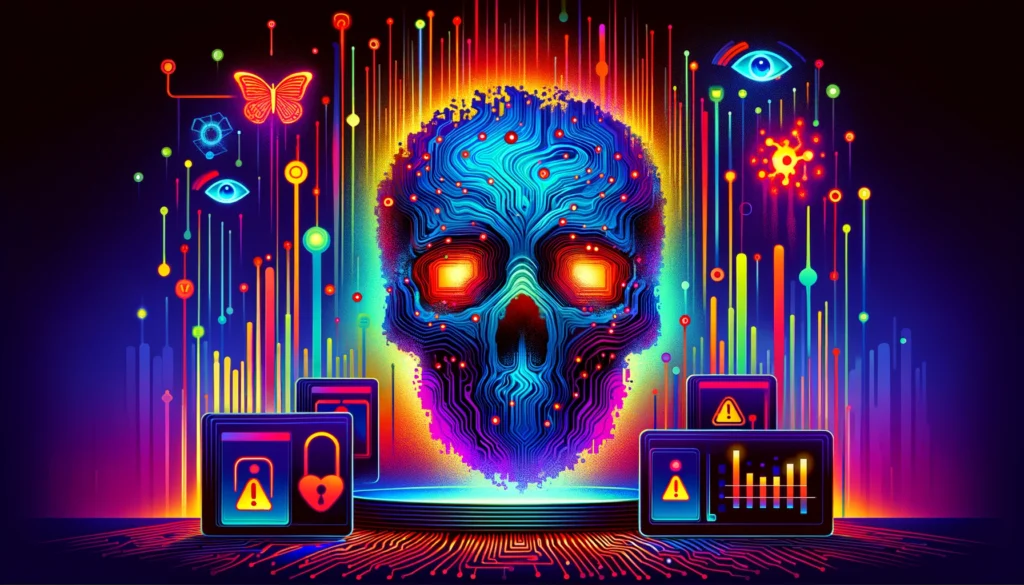
AI’s Hidden Weakness: What Are Adversarial Attacks?
Adversarial attacks manipulate AI by subtly altering the input data to deceive models into making mistakes.
Adversarial attacks expose a fundamental vulnerability in AI algorithms. AI can be tricked by minor changes in input—like an image or text—into making incorrect predictions. The results range from misclassifying an object to making dangerous decisions in automated systems.
Imagine a self-driving car misidentifying a stop sign as a yield sign due to minor visual distortion. That’s the kind of threat adversarial attacks pose.
The Sneaky World of Adversarial Examples
Adversarial examples are carefully crafted inputs designed to confuse AI. What’s fascinating is how small and imperceptible these modifications can be. For example, changing a few pixels in an image can cause a classifier to misinterpret it entirely.
Researchers have shown that these attacks can fool some of the most sophisticated AI models. An image that looks like a dog to humans might be interpreted as a wolf by AI, just because of a few pixel tweaks.
This deceptive nature makes adversarial examples dangerous. If left unchecked, they could compromise critical systems, from security cameras to autonomous drones.
Types of Adversarial Attacks: From Subtle to Severe
Adversarial attacks come in various forms, each exploiting different weaknesses of AI systems. The most common types include:
- Evasion Attacks: These involve modifying input data to fool an AI during its prediction phase. A classic example is altering an image or voice recording to bypass a security system.
- Poisoning Attacks: In these attacks, the training data of an AI model is intentionally manipulated. Poisoning compromises the entire learning process, making the AI vulnerable long before it even begins making decisions.
- Exploratory Attacks: These attacks probe AI systems to learn their behavior, then use this knowledge to exploit weaknesses. By understanding the system’s patterns, attackers can craft even more sophisticated adversarial examples.
Each type of attack poses unique challenges for defending AI systems. The sheer variety makes it difficult to devise universal safeguards.
How Hackers Are Exploiting AI’s Vulnerabilities
Hackers are continuously innovating in the world of adversarial attacks. Some have found ways to bypass AI-based security systems with surprisingly minimal effort. In some cases, all it takes is adding a sticker to a street sign or using a manipulated image to fool surveillance systems.
What makes these attacks particularly concerning is the low-cost nature of launching them. You don’t need supercomputers or advanced knowledge—just the right tweaks in data.
Imagine a malicious actor slightly modifying a company’s financial data, tricking its AI-driven decision-making process into making faulty investments. That’s the level of disruption adversarial attacks could cause.
Why AI’s Complexity Is Its Biggest Weakness
The complexity of AI models is a double-edged sword. On the one hand, deep neural networks enable AI to perform tasks once thought impossible—like real-time language translation or cancer diagnosis from images. But this complexity also makes them vulnerable to manipulation.
AI models, particularly those with deep learning architectures, rely on vast amounts of data and numerous parameters to function. While this makes them powerful, it also means that even tiny changes in input can create unexpected behavior.
Defending Against Adversarial Attacks: Is It Possible?
Given how easily AI systems can be tricked, the natural question is—how do we defend against these attacks? Thankfully, researchers are actively developing techniques to harden AI against adversarial manipulation. But, like all cybersecurity challenges, it’s a game of cat and mouse.
One approach is adversarial training, where models are exposed to adversarial examples during their learning phase. This forces the AI to recognize and resist deceptive inputs. It’s like giving AI a sort of immune system against malicious data. However, even this method has limits—new and unforeseen adversarial examples can still bypass defenses.
Another strategy is robust optimization. This method involves refining the model’s parameters to make it more resilient to slight changes in input. The idea is to make the AI less sensitive to minor alterations, thus reducing its chances of being fooled.
The Role of Explainability in AI Security
One of the major issues with AI is its “black box” nature. Most AI models, especially deep learning networks, don’t offer clear insight into how they arrive at their decisions. This lack of transparency makes it hard to understand why AI makes errors when under adversarial attack.

Explainable AI (XAI) aims to change that. By making AI decision-making more transparent, researchers and developers can identify potential vulnerabilities more easily. If we can understand why an AI model is fooled by a particular adversarial example, we have a better chance of defending against it.
Explainability could also improve trust in AI systems. If users understand how an AI arrives at its conclusions, they’re more likely to trust its predictions—even if they know it could be attacked.
Real-World Implications: When Adversarial Attacks Turn Dangerous
Adversarial attacks may sound like an abstract problem, but their real-world implications are staggering. Think about the growing use of AI in critical infrastructure. From managing energy grids to controlling public transportation, AI is becoming deeply integrated into the systems that keep our societies running.
Now imagine an adversarial attack that tricks AI systems managing traffic lights. A small data manipulation could lead to disastrous accidents, putting lives at risk. The stakes are even higher in healthcare, where AI systems assist doctors in diagnosing patients. A wrong diagnosis caused by a poisoned input could lead to misinformed treatments.
Then there’s the risk in finance. AI algorithms manage everything from stock trading to fraud detection. A well-executed adversarial attack could crash markets or allow criminals to bypass security protocols, leading to financial chaos.
The Future of AI Security: Constant Evolution
Adversarial attacks reveal that AI security must evolve constantly. As hackers discover new vulnerabilities, the defense strategies need to adapt in real-time. This is why collaboration between AI developers, cybersecurity experts, and policymakers is crucial.
AI systems can’t just be designed and left on autopilot. They need continuous monitoring, regular updates, and rigorous testing against new types of adversarial examples. The cost of inaction could be catastrophic, especially as AI takes on more responsibilities in areas like national defense and law enforcement.
In the future, AI models might even start to “self-defend.” There is ongoing research into systems that can detect adversarial attacks in real-time and adjust their predictions accordingly. This would create a more dynamic defense system, where the AI constantly adapts to new threats as they arise.
How Users Can Stay Safe in an AI-Driven World
As individuals, we may not be building AI systems, but that doesn’t mean we’re powerless against adversarial attacks. Awareness is key. Whether it’s an AI-powered security system or a virtual assistant, users should be aware that AI isn’t infallible.
Always question unexpected AI behavior, especially in critical applications like online banking or identity verification systems. If something seems off, report it. As consumers, we play a vital role in pushing companies and governments to prioritize AI security.
The Ethical Dilemma of Adversarial Attacks
As AI systems become increasingly integrated into everyday life, adversarial attacks raise serious ethical concerns. Who should be held accountable when an AI system is compromised? Should the responsibility fall on the developers, or is it up to organizations using the technology to ensure security?
This dilemma gets even more complicated when you consider AI systems being used for sensitive purposes—like criminal justice or hiring. If a bias in the AI’s decision-making can be exploited through adversarial attacks, the repercussions could be devastating for individuals. An attack could manipulate AI to unfairly deny someone a job or even wrongly identify them as a suspect in a criminal investigation.
Governments and regulatory bodies need to address these ethical concerns head-on. Clear guidelines must be put in place to ensure that AI developers are held to high standards of security, transparency, and fairness. Without such regulations, we could see the widespread abuse of AI vulnerabilities with little to no accountability.
Legal Ramifications: Can We Regulate Adversarial Attacks?
The legal framework surrounding AI security is still in its infancy. While laws governing data protection and cybersecurity exist, specific regulations aimed at preventing adversarial attacks on AI systems are largely missing.
One of the challenges here is that adversarial attacks can be incredibly subtle. It’s difficult to prove intent or trace the attack back to its source. This opens up a legal gray area where attackers may not face significant consequences, especially if they exploit these vulnerabilities in countries with less stringent cybersecurity laws.
Another legal question surrounds the liability of AI developers. If an AI system fails due to an adversarial attack, should the company that built the model be held liable for damages? Or is it the responsibility of the users who implemented the AI in their systems? These are questions that the legal system has yet to fully address.
As adversarial attacks become more sophisticated, the need for global standards in AI security becomes more urgent. Governments, industries, and research communities must collaborate to create laws that hold all parties accountable, from developers to end-users.
Industries Most at Risk: Who Should Be Worried?
While every industry using AI should be concerned about adversarial attacks, certain sectors are especially vulnerable.
The financial industry tops the list. With AI handling transactions, risk assessments, and fraud detection, even minor adversarial manipulations could lead to massive financial losses. Imagine a hacker exploiting an AI model that predicts stock prices or approves loan applications. The damage could ripple across entire economies.
The automotive industry is another area where adversarial attacks could have life-or-death consequences. Self-driving cars rely on AI to interpret their surroundings. A simple adversarial attack that alters a stop sign or road marking could confuse the vehicle, leading to potentially fatal accidents.
Healthcare is no less vulnerable. With AI increasingly used in diagnosis and treatment planning, adversarial attacks that manipulate medical images or patient data could result in misdiagnoses or incorrect treatments. These attacks could directly impact patient outcomes, making the healthcare sector a prime target for malicious actors.
The Role of AI in Defending Against Adversarial Attacks
Interestingly, AI itself may be the best tool we have to combat adversarial attacks. Researchers are developing AI-driven cybersecurity systems that can detect unusual patterns in data and identify potential threats. These AI systems act like immune systems, constantly monitoring for signs of manipulation and alerting users to suspicious activity.
Machine learning algorithms can also be used to predict potential attack vectors, giving developers a chance to fortify their systems before an attack occurs. This proactive approach could significantly reduce the number of successful adversarial attacks.
Moreover, AI-driven tools can be employed to conduct penetration testing on other AI models. This means that AI could be used to simulate attacks, helping developers understand where their systems are most vulnerable and allowing them to patch security holes before real attackers exploit them.
The Need for a Cultural Shift in AI Security
The rise of adversarial attacks is a wake-up call for the entire AI community. Security can no longer be an afterthought in AI development—it must be a priority from the very beginning. Companies that develop AI systems need to invest more in robustness testing and security measures.
Developers should also work closely with cybersecurity experts to ensure that their models are resistant to attacks. This might involve adopting multi-layered defense strategies, such as combining adversarial training with continuous monitoring and real-time threat detection.
At the same time, there needs to be a cultural shift in how we think about AI security. AI is no longer just a tool for convenience; it’s a core component of critical infrastructure. As such, the public and private sectors must collaborate to develop best practices and standards that ensure AI systems are both secure and trustworthy.
If this cultural shift doesn’t happen soon, we could be facing a future where adversarial attacks become as common—and as damaging—as traditional cyberattacks.
Preparing for the Future: Proactive AI Security Strategies
With adversarial attacks growing in sophistication, organizations need to adopt proactive strategies to safeguard their AI systems. It’s not enough to react after an attack—companies must anticipate these threats from the start.
One key strategy is to incorporate adversarial testing as a routine part of AI development. Just as software is subjected to vulnerability tests before release, AI models should undergo stress tests that simulate adversarial scenarios. This will help developers identify weak points and make necessary adjustments early on.
Another essential tactic is investing in cross-discipline training for teams. Cybersecurity experts should work alongside AI engineers to develop a comprehensive understanding of where models are most vulnerable. Bridging this gap between AI and cybersecurity will create stronger, more resilient systems that are less susceptible to manipulation.
Collaboration Is Key: Building a Global AI Security Framework
One of the most promising solutions to the threat of adversarial attacks lies in collaboration between countries, industries, and research institutions. AI is a global technology, and its security should be treated as a global issue. No single company or country can handle this threat alone.
To address this, international bodies like the United Nations or the World Economic Forum could spearhead the creation of a global AI security framework. Such a framework would establish guidelines for AI development, ensure the sharing of security best practices, and promote joint research initiatives on adversarial attacks.
AI security needs to become as standardized and universally accepted as data privacy regulations like the GDPR. Only through global cooperation can we hope to stay ahead of attackers who continually find new ways to exploit AI systems.
Balancing Innovation and Security in AI Development
The race to innovate in AI is fierce, with companies and governments striving to outpace each other in developing more powerful models. However, this focus on speed and innovation often comes at the expense of security. In the rush to deploy cutting-edge AI systems, vulnerabilities are frequently overlooked.
It’s crucial for AI developers to strike a balance between innovation and security. Prioritizing security may seem like it slows progress, but it’s far better to build secure systems from the ground up than to scramble for fixes after an attack. Regulatory bodies could play a role here by enforcing security standards and rewarding organizations that prioritize robustness and safety in their AI systems.
Educating the Next Generation of AI Experts
Finally, the battle against adversarial attacks will require a new generation of AI professionals trained not just in machine learning, but also in AI security and ethics. Universities and educational institutions should place a greater emphasis on teaching students about adversarial attacks and how to build systems that can resist them.
As AI becomes more ubiquitous, professionals entering the field must understand the potential risks associated with their creations. Ethical AI development should be woven into the fabric of AI education, ensuring that future engineers, data scientists, and policymakers are well-equipped to handle the challenges of adversarial threats.
Adversarial attacks on AI systems are a critical threat, but with a concerted effort across industries and governments, these vulnerabilities can be addressed. Building more resilient AI models, educating teams, and fostering international collaboration will be key to ensuring the secure and ethical development of artificial intelligence in the years to come.
Resources
Books
- “Adversarial Machine Learning” by Yevgeniy Vorobeychik and Murat Kantarcioglu
This book provides a comprehensive introduction to the field of adversarial attacks and defenses. It covers both theoretical foundations and practical applications. - “Deep Learning Security” by Nitesh Saxena, XiaoFeng Wang, and Shuang Hao
Focuses on the security risks associated with deep learning, including adversarial attacks, and offers insights into improving the robustness of AI systems.
Research Papers
- “Explaining and Harnessing Adversarial Examples” by Ian J. Goodfellow, Jonathon Shlens, and Christian Szegedy
This seminal paper outlines the basic concepts of adversarial attacks and introduces adversarial training as a defense mechanism.
Read the paper here - “Adversarial Attacks and Defenses in Image Classification: A Comprehensive Review” by Mahmood Sharif et al.
A detailed review of adversarial attacks specifically in image classification models, along with the various defense strategies being developed.
Read the paper here
Online Courses
- Coursera: “AI For Everyone” by Andrew Ng
A beginner-friendly course that introduces the basics of AI and machine learning, with some discussion on adversarial vulnerabilities and AI ethics.
Enroll here - Udemy: “Cybersecurity in Machine Learning and AI”
This course covers security concerns in AI systems, including adversarial attacks, and provides hands-on examples of how to secure machine learning models.
Organizations & Research Labs
- MIT-IBM Watson AI Lab
Conducts cutting-edge research in AI, including adversarial robustness and security. They regularly publish findings on securing AI systems against various attacks.
Explore here - OpenAI
OpenAI is at the forefront of AI research, including adversarial attacks. Their blog and research papers often highlight advancements in understanding and defending AI systems.
Visit their site
Blogs & Articles
- “A Tour of Adversarial Attacks and Defenses in Machine Learning” by Towards Data Science
An easy-to-understand overview of the landscape of adversarial attacks and the current state of defenses in machine learning. - Google AI Blog: “Building Robust Systems Against Adversarial Examples”
Google’s AI research team discusses their efforts to create more resilient AI systems and explains various approaches to defending against adversarial examples.





